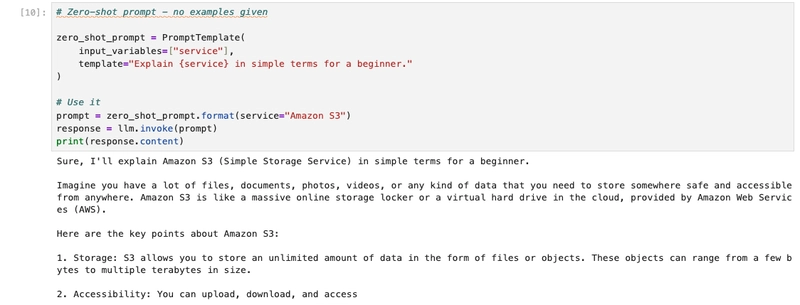Welcome to Day 2 of our LangChain + AWS Bedrock journey! Today we dive into the art and science of prompt engineering - the skill that transforms simple text into powerful AI interactions.
What We'll Learn Today
- Zero-shot prompting: Getting results without examples
- Few-shot prompting: Learning from examples
- Role prompting: Making AI adopt specific personas
- Model parameters: Fine-tuning AI behavior (temperature, top_p, max_tokens)
Setup (Continuing from Day 1)
Assuming you have the packages and bedrock client from Day 1, let's initialize our Claude model with specific parameters for today's experiments:
from langchain_aws import ChatBedrock
from langchain.prompts import PromptTemplate
# Initialize Claude with parameters for prompt engineering
llm = ChatBedrock(
model_id="anthropic.claude-3-sonnet-20240229-v1:0",
region_name="us-east-1",
model_kwargs={
"max_tokens": 150,
"temperature": 0.7,
"top_p": 0.9
}
)Understanding Prompt Engineering
Prompt engineering is the art of crafting instructions that guide AI models to produce desired outputs. Think of it like being a director giving instructions to an actor - the clearer and more specific your direction, the better the performance.
The key principles are:
- Clarity: Be specific about what you want
- Context: Provide relevant background information
- Constraints: Set boundaries (length, format, tone)
- Examples: Show the desired output style when needed
1. Zero-Shot Prompting
Zero-shot prompting is like asking someone to perform a task they've never seen before, relying purely on their general knowledge and understanding. The model uses its pre-trained knowledge without any specific examples.
When to use Zero-shot:
- Simple, well-defined tasks
- When the model already understands the domain
- For general knowledge questions
- When you want the model's "natural" response
Advantages:
- Quick and simple
- No need to prepare examples
- Works well for common tasks
Limitations:
- May not follow specific formats
- Less control over output style
- Can be inconsistent for complex tasks
# Zero-shot prompt - no examples given
zero_shot_prompt = PromptTemplate(
input_variables=["service"],
template="Explain {service} in simple terms for a beginner."
)
# Use it
prompt = zero_shot_prompt.format(service="Amazon S3")
response = llm.invoke(prompt)
print(response.content)2. Few-Shot Prompting
Few-shot prompting is like showing someone examples before asking them to do a task. You provide 2-5 examples of the desired input-output pattern, then ask the model to follow the same pattern.
When to use Few-shot:
- When you need consistent formatting
- For complex or unusual tasks
- When zero-shot results are inconsistent
- To establish a specific style or tone
Advantages:
- Better control over output format
- More consistent results
- Can teach complex patterns
- Reduces need for detailed instructions
Best practices:
- Use 2-5 examples (more isn't always better)
- Make examples diverse but consistent
- Show edge cases if relevant
- Keep examples concise
# Few-Shot Prompting
few_shot_prompt = PromptTemplate(
input_variables=["service"],
template="""
Explain AWS services using this format:
Example 1:
Service: Amazon EC2
Simple Explanation: Virtual computers in the cloud that you can rent by the hour.
Example 2:
Service: Amazon RDS
Simple Explanation: Managed database service that handles backups and updates automatically.
Now explain:
Service: {service}
Simple Explanation:"""
)
# Use the few-shot prompt
prompt = few_shot_prompt.format(service="Amazon Lambda")
response = llm.invoke(prompt)
print(response.content)3. Role Prompting
Role prompting assigns a specific identity, profession, or perspective to the AI. It's like asking the model to "act as" someone with particular expertise, personality, or viewpoint.
Why Role Prompting works:
- Models have learned associations between roles and communication styles
- Provides context for appropriate language and knowledge level
- Helps generate more engaging and targeted responses
- Leverages the model's understanding of different perspectives
Types of roles:
- Professional roles: "You are a software architect", "You are a teacher"
- Personality traits: "You are enthusiastic", "You are patient and methodical"
- Expertise levels: "You are a beginner", "You are an expert"
- Creative personas: "You are a poet", "You are a storyteller"
Best practices:
- Be specific about the role's characteristics
- Include relevant context about the audience
- Combine roles with other prompting techniques
- Test different roles to find what works best
role_prompt = PromptTemplate(
input_variables=["service", "role"],
template="""
You are a {role}. Explain {service} from your perspective.
Keep it engaging and use language appropriate to your role.
"""
)
# Test different roles
roles = ["friendly teacher", "creative poet", "cricket commentator"]
for role in roles:
print(f"\n{role.title()}:")
prompt = role_prompt.format(service="Amazon Lambda", role=role)
response = llm.invoke(prompt)
print(response.content)
print("-" * 40)Model Parameters
The model_kwargs parameter controls AI behavior:
Key Parameters
- max_tokens: Response length (50-150 for short, 200-500 for detailed)
- temperature: Creativity level (0.2 = focused, 0.7 = balanced, 0.9 = creative)
- top_p: Word diversity (0.8 = focused, 0.9 = balanced)
Quick Examples
# Factual responses
factual_kwargs = {"max_tokens": 150, "temperature": 0.2, "top_p": 0.8}
# Creative responses
creative_kwargs = {"max_tokens": 300, "temperature": 0.9, "top_p": 0.95}Key Takeaways
Core Prompting Techniques:
- Zero-shot: Direct instructions, relies on model knowledge
- Few-shot: Provide examples to guide format and style
- Role prompting: Adopt personas for engaging explanations
Model Control:
- Parameters: Fine-tune behavior with temperature, top_p, max_tokens
Best Practices
Getting Started:
- Start Simple: Begin with zero-shot, add complexity as needed
- Be Specific: Vague prompts lead to inconsistent results
- Test Iteratively: Refine prompts based on outputs
Improving Results:
- Use Examples: Show don't just tell what you want
- Set Constraints: Guide the model with clear boundaries
- Consider Context: Provide relevant background information
Optimization:
- Monitor Parameters: Adjust temperature and top_p for your use case
- Test Edge Cases: Try unusual inputs to test robustness
Common Pitfalls to Avoid
- Over-prompting: Too many instructions can confuse the model
- Ambiguous language: Be precise in your requirements
- Ignoring context length: Very long prompts may get truncated
- Not testing edge cases: Try unusual inputs to test robustness
- Fixed parameters: Different tasks need different temperature/top_p values
- Inconsistent examples: Make sure few-shot examples follow the same pattern
About Me
Hi! I'm Utkarsh, a Cloud Specialist & AWS Community Builder who loves turning complex AWS topics into fun chai-time stories ☕
This is part of my "LangChain with AWS Bedrock: A Developer's Journey" series. Follow along as I document everything I learn, including the mistakes and the victories.


